

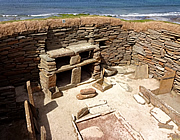
The mainland of Orkney is scattered with atmospheric remains from the Neolithic including famous Skara Brae, an amazingly well-preserved settlement.
Orkney pages:
Orkney
Neolithic Orkney
Broch of Gurness, Yesnaby Cliffs, Marwick Head
Rousay & Hoy
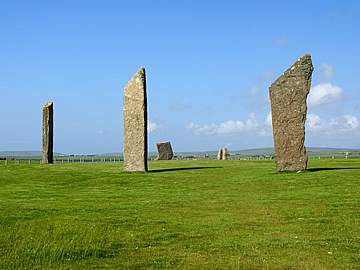
One of the oldest stone circles in Britain, though only three and a bit uprights remain alongside. The stones were raised around 3,100BC and originally there were 11 or 12 uprights surrounded by a ditch and bank. A single causeway crossed the ditch into the circle on the north side, in the direction of Barnhouse settlement. Within the circle there was a large stone hearth, a feature common to Neolithic houses. At Stenness the hearth may have had a ceremonial role.
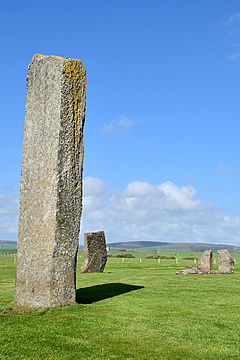
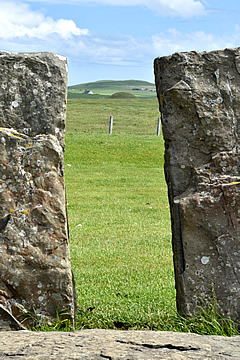
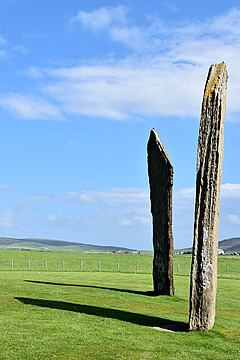
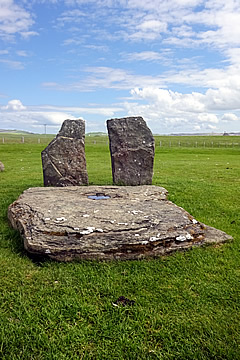
Two short erect stones and a flat slab can be seen within the circle on the north side. Walter Scott, having visited in 1814, had said that these probably formed part of a "sacrificial altar"! In 1907 the flat slab was placed on top of these two stones, plus another, to create a dolmen-like structure. This was toppled in 1972 when serious excavations were undertaken to try to determine just where these stones originated and what their purpose was. The stones are probably remnants of the original site but it is unknown whether the flat slab even belongs here.1
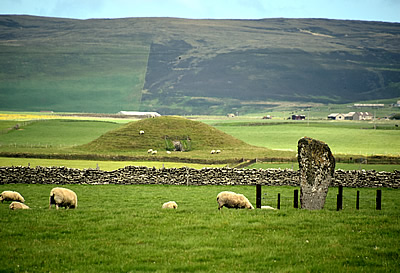
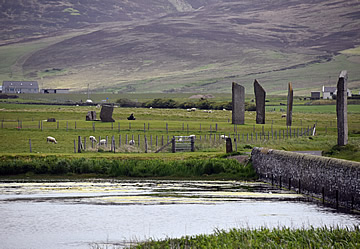
Although the Neolithic chambered cairn of Maeshowe can be viewed through the two short uprights, there does not seem to be any significance to this.
However, further south east of Maeshowe, the Barnhouse Stone is perfectly aligned with the entrance to the cairn. At winter solstice, the last rays of the setting sun shine directly through its entrance to illuminate the interior. The central axis of the oval cairn, through the entrance, is directly aligned with the Barnhouse Stone, so that anyone standing in the entrance would see the sun go down directly above the Barnhouse Stone as their shadow was cast back into the chamber.
Maeshowe chambered cairn was unfortunately closed while we were on Orkney because of Covid restrictions.
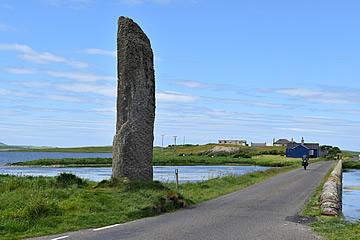
It is thought that there were once many more standing stones in the vicinity. Only a few remain, including the Watchstone, a huge monolith, around 5.6m high, close to the circle at the Brig o' Brodgar between Harray and Stenness lochs.
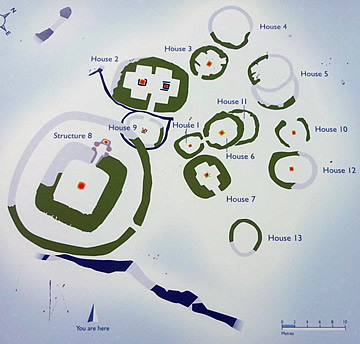
Barnhouse settlement lies very close to the Standing Stones of Stenness, on the south shore of the Loch of Harray. The lower walls and stone slabs that comprise the visible remains were reconstructed after the site was discovered in 1984 and archaeological excavations completed.
It dates from the same era as the Standing Stones of Stenness, around 3,000BC, and it seems likely that the people who lived here used, and perhaps even created, the stone circle - the causeway entrance to the stone circle is towards Barnhouse. The settlement may have been the home of ceremonial "priests".
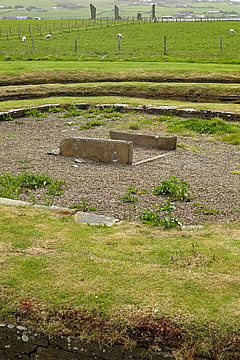
The houses were built in phases, the earliest being 2, 9 and 3, and possibly the early version of 5. These also share a common drainage system2
The buildings have typical Neolithic features such as a central hearth, older houses have recesses for stone beds. Later the buildings become squarer with rounded corners and furniture is set against walls rather than in recesses.
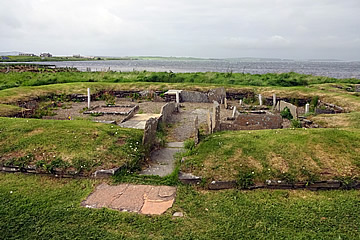
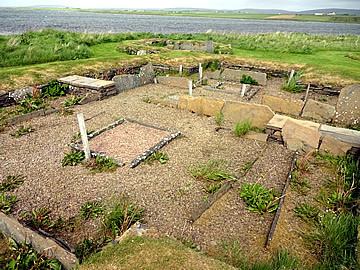
The houses were probably free-standing, with dry stone stone walls and possibly roofed with turf. Many were rebuilt over time. For instance House 12 was first built in 3100-3050BC, and rebuilt 3025-2975BC. The final houses to be built were 4 and 11, 3000-2950BC. On the site map it looks as if 6 was built after 11, but ref 2 is quite clear that 11 is later.
The whole settlement was eventually abandoned, lasting a little more than 200 years. Curiously all of the structures were demolished at this point.
Though the houses have similarities to other Neolithic settlements in Orkney, the overall structure of the settlement is quite unique.
House 2 is quite unusual. It has two chambers separated by a central alleyway from the entrance. Each chamber has its own hearth. A burial cist in the floor suggests that it may have been a ceremonial, rather than domestic, building. The masonry walls were of very high quality and there are six rectangular recesses within, so perhaps this was a high class chambered tomb? Or maybe "priests" of Stenness performed rituals here. It was one of the the earliest houses to be built at the settlement and evidence suggests that it was a place of manufacture of fine objects such as maceheads and axes.2
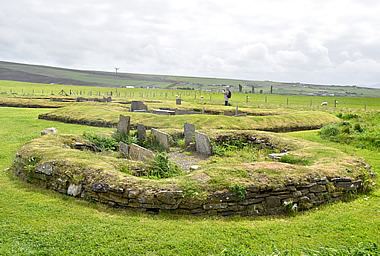
Structure 8 is also atypical and it is perhaps significant that it was almost the final structure built at Barnhouse.2
While the houses developed over a period of time from the late 32nd century BC, Structure 8 was probably built 3,025-2,975BC. It is possible that House 2 went out of use before the end of the settlement, and Structure 8 was probably the last to be abandoned, probably during the early part of the 29th century BC.

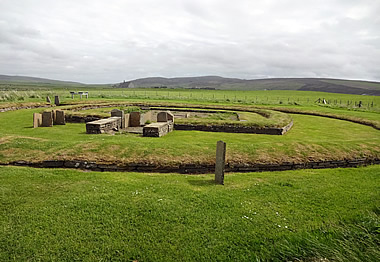
Structure 8 is much larger than the others encompassed by a 1.5m thick stone wall, 26m in diameter. The wall encloses a clay platform on which the building stands. Excavations in the area uncovered between the outer wall and the building uncovered pits and furnaces, suggesting cooking and other activities.
The building itself is square with rounded corners and had 3m thick walls, accessed by a "monumental" entrance, a corridor lined with upright stones. Two further uprights flanked the entrance, and two smaller upright stones stood either side of what might have been a ceremonial walkway extending out into the platform.
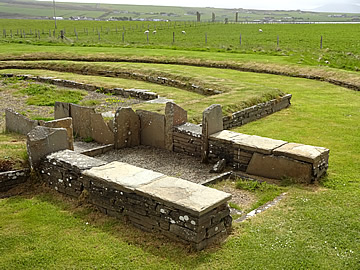
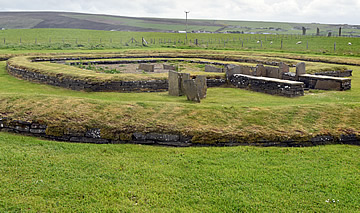
Inside there was large hearth in the centre and evidence of a stone dresser opposite the entrance. Skara Brae is noted for its dressers, however, here furniture sits back against a wall, rather than in recesses.
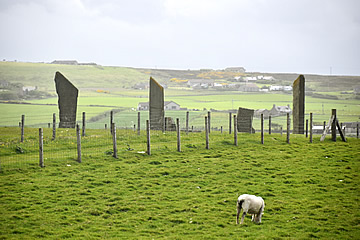
It could have been simply a very large, prestigious home - it has the traditional layout, though the most popular theory is that it was a ceremonial building associated with the Standing Stones of Stenness.
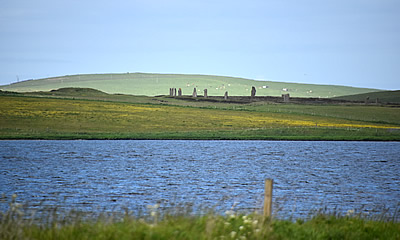
Passing the Watchstone and crossing the causeway between the Lochs of Stenness and Harrey brings you to the Ness of Brodgar and, ultimately, the Ring of Brodgar. The Ness is a strip of land separating the two lochs and there are significant archaeological remains here. There is an ongoing dig which is intermittently open for free tours but we were a little early in the season for that.
The complex being uncovered here is at least 5,000 years old with structures dating from 3200BC, most of which were out of use by 2,900BC. Evidence suggests that it was a meeting place for people from far and wide.

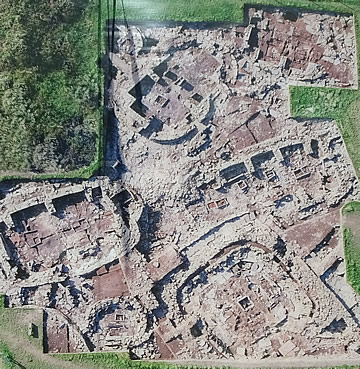
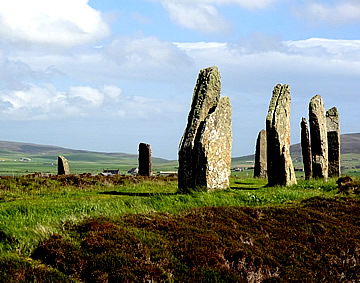
A huge squarish building, 20m x 19m with 5m thick walls, was erected at about the same time, 2,900BC. This monumental structure is surrounded by an external passageway. It had an entrance courtyard flanked by monumental stones, a similar style to Structure 8 at Barnhouse which was built around the same time. This building's use came to an end around 2500BC, when a feast was held in which a large number of cattle were consumed and the bones placed in the outer passageway, later overlaid with deer carcasses.3
A wealth of incised and decorated stone has been found at the site, many with beautiful geometric designs, and even the remnants of painted walls. Much remains to be discovered - less than 10% of the site has been investigated so far.
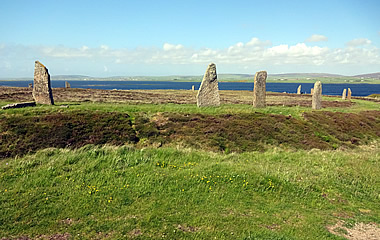
The Ness lies between the two stone circles of Stenness and Brodgar.
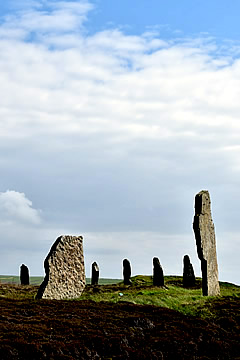
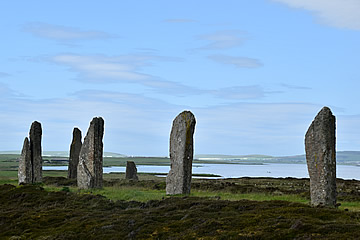
The Ring of Brodgar is massive, 103.6m in diameter surrounded by a ditch, far larger than the Standing Stones of Stenness - though the latter has bigger stones and its own quiet beauty. Only 27 stones remain, though excavations suggest there were once more than 70, not necessarily all standing at the same time.3 The ring is thought to date from between 3,000 and 2,500BC, not as old as the Stones of Stenness, and built after the settlement at the Ness was already established. It stands in a natural amphitheatre between the Lochs of Stenness and Harray.
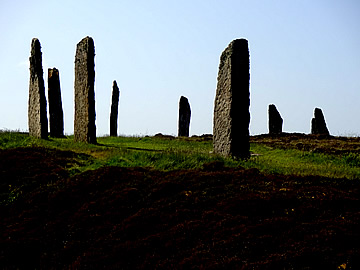
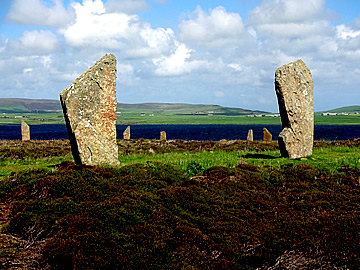
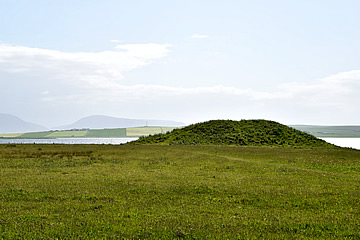
A compelling theory is that the circle itself was not the most important aspect, but rather the quarrying and erection of the stones. This took place over the course of generations, stones toppling (they had very shallow socket holes, between 18cm and 27cm), others being erected.
Geological examination has shown that the stones come from at least seven different quarries across Orkney.3 The stones from different quarries are grouped together, so perhaps different island communities had their place in the ring. The ring may well, therefore, have looked in the past much as it does now, with gaps and clusters of megaliths. The whole process, if this is the case, is reminiscent of the statues of Easter Island, which are thought to represent clan ancestors. The larger and more imposing the statue, the greater the power of the clan.
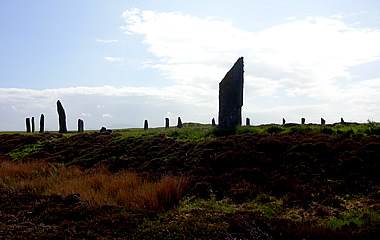
There are four Bronze Age burial mounds in the vicinity. South west of the ring is Salt Knowe. Unlike Plumcake Mound to the north, which revealed a couple of stone cists and urns with cremated human remains, Salt Knowe has not yet been excavated. It is the largest mound here, similar in size to Maeshowe, and perhaps conceals further Neolithic tombs.
There are some really nice fact sheets at the site with FAQs and interesting snippets.
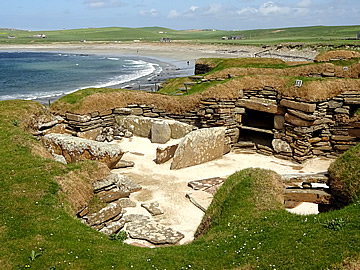
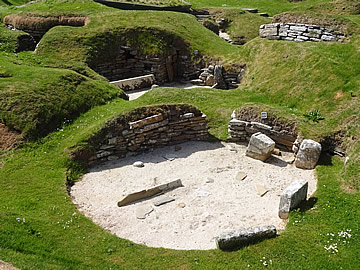
Justly famous, Skara Brae is an amazing Neolithic site.
It stands in a spectacular location above the Bay of Skaill, rather exposed to the almost constant winds of Orkney, and it was a severe storm which exposed the settlement in the winter of 1850. The Laird of Skaill, William Watt, who lived at nearby Skaill House, first investigated the site, collecting a large number of artefacts. By 1968 four houses had been substantially revealed. In 1925, after another storm threatened the site, a sea wall was built and Professor Vere Gordon Childe undertook professional archaeological work.4
The homes uncovered were found to have been submerged in a midden, which afforded protection from the prevailing windy weather and frequent winter storms. Connected by covered passageways the houses would have retained heat much better in this arrangement.
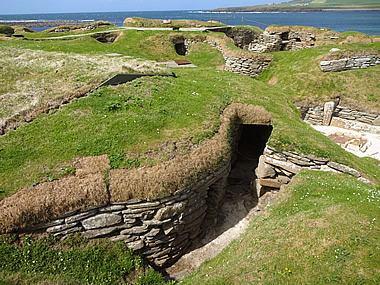
The midden was essentially kitchen refuse: "broken and more or less decayed animals' bones, limpet shells, ashes, cracked stones, coarse and very friable potsherds, and various artifacts, including Skail flakes, bone pins, beads, etc."4 The various components of the midden were not in discernable layers, and the identified artefacts were of identical form, irrespective of their depth within the midden, suggesting they all belong to the same era of occupation. The site was occupied from around 3200BC to 2500BC.
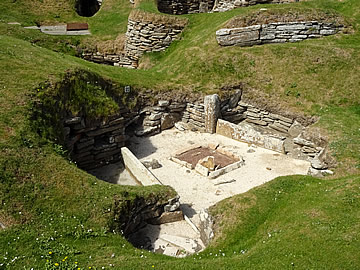
Early houses were circular, later houses were larger and roughly square in shape, with rounded corners - the same shape as the monumental buildings at both Barnhouse (Structure 8) and Ness of Brodgar.4 And whereas the early houses had beds set into recesses in the walls, in the later houses they were placed against the walls. The furniture was made from local flagstones which were easy to work.
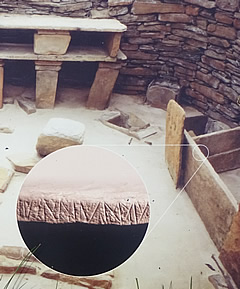
Houses 9 and 10 are the earliest on the site.
House 7 contains the best carvings found at Skara Brae, geometric shapes carved onto the top ledge of a slab forming the side of a bed, but for preservation reasons it is not accessible.
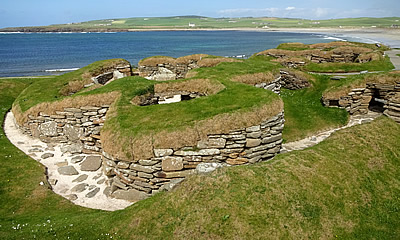
Structure 8 is the only building which is not a house. Though it has a central hearth it has no beds or dresser. It was also not buried in midden material and consequently had thicker walls. It is thought to have been a workshop for making stone tools and perhaps pottery, bone tools and wooden implements.
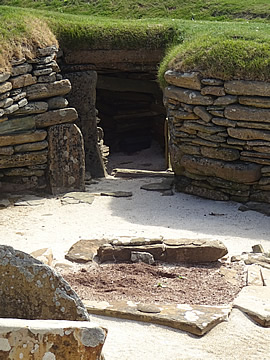
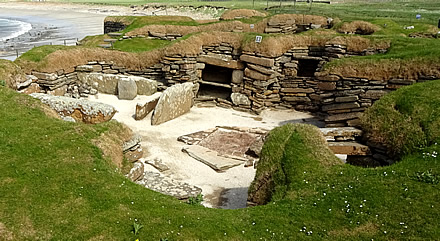
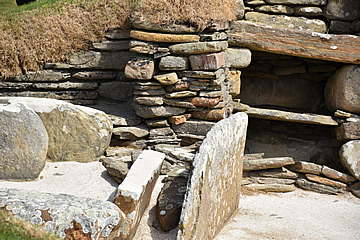
Houses 1 and 2 lie next to each other on what is now the outer edge of the settlement towards the bay. It is at least possible that Skara Brae was much bigger in Neolithic times.
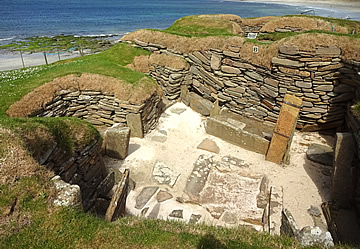
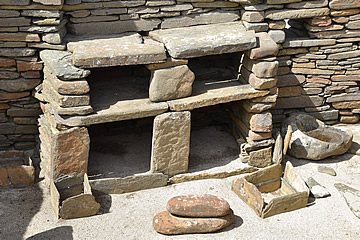
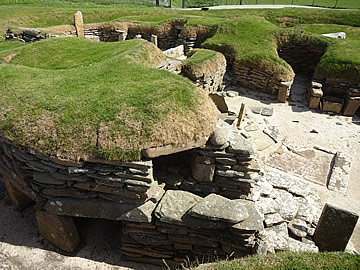
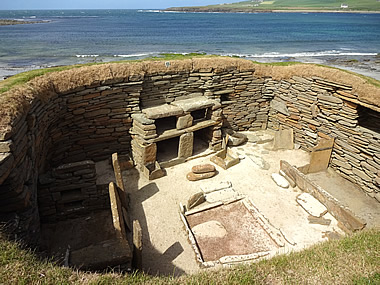
Structure 1 is the iconic showcase house of Skara Brae. With its virtually intact dresser and stone beds it creates a vivid impression of life in Neolithic times.
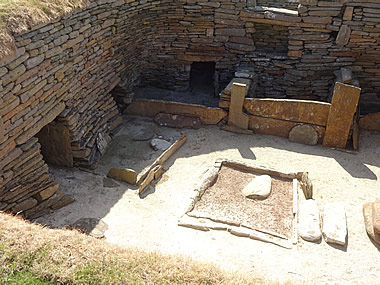
Because the houses are very similar in size and style, it has been postulated that Skara Brae was a very egalitarian society, with no one person raised in status above another. However, if this is only a part of the original settlement, there is surely room for doubt and much may remain to be discovered.
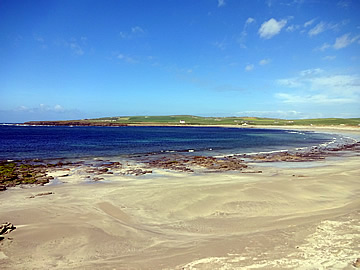
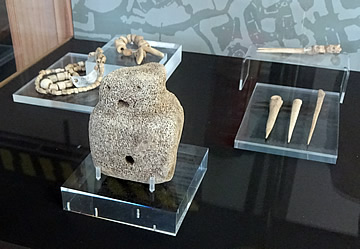
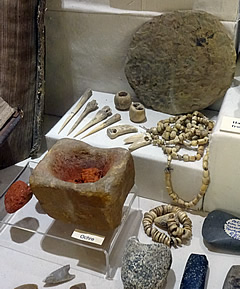
The museum in Stromness has a number of fascinating artefacts discovered at Skara Brae, in particular the whalebone figurine nicknamed "Buddo", the affectionate Orcadian term for "friend". Buddo was found in a stone bed compartment in House 3.
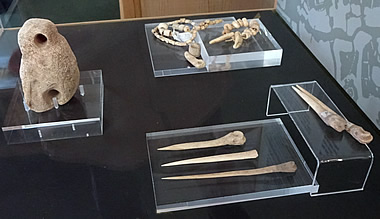
References